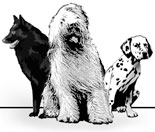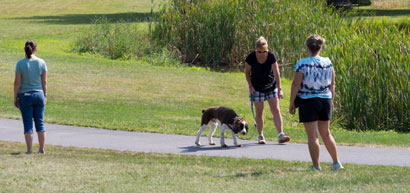What happens when you realize there’s another dog (or a jogger or bicycle) in the vicinity? Do you cringe? Do you get that sinking feeling because you know what’s about to happen? Do you tighten up on the leash in anticipation of the lunging? Do you hold your breath? What happens when your dog starts his “aggressive” routine? Do you pull back on the leash? Do you yell at your dog? Or do you tell him “it’s OK?” Do you try to hold him back physically? Believe it or not, some of these things are reinforcing to your dog. But ALL of them affect change in your dog’s behavior. Think about it: every time he sees another dog and he’s on his leash, he gets a leash correction. This teaches your dog that there’s an association between dogs and pain/discomfort in his neck, or at the very least, that his person becomes very upset when there’s another dog nearby. There must be a good reason to be leery of those other dogs, then. No wonder he reacts to other dogs!
-- Please see our most recent Reactive Dog blog - "People Are OK"
Well, what about the yelling? Or telling him “it’s OK”? Why don’t they work? In order to understand what’s going on, we need to learn a few more concepts.
We can make our dog’s behavior change in three different directions. The first is the one we learned earlier in the book: to enhance the behavior through positive reinforcement. That would be something like “it’s OK Rover; that doggy’s not going to hurt you.” While it’s clear to us what we mean to say, our dogs don’t understand English. But although he doesn’t understand the words, the tone is one he’s heard before: soothing, encouraging. “Oh,” he thinks. “She wants me to keep doing this! Got it!” And so your dog steps up his efforts to drive the other dog away.
The second way we could change the behavior is to diminish the behavior through the use of positive punishment. Positive punishment is anything which follows a behavior which is aversive to the dog and which serves to decrease the chances that that behavior will happen again. So, you think, I’ll just yell at him. That’ll stop him. Think again. While your dog is barking, he’s barely hearing your voice behind him. And he doesn’t know what you’re saying, but you must be encouraging him. After all, you’re the “big guns” behind him. While you think you’re punishing him, he thinks your salutations are supporting him. This is, then, positive reinforcement, which enhances the behavior, rather than positive punishment, which diminishes it.
Positive punishment can be effective if it’s severe enough. You should only need to use positive punishment one or two times in order to make that behavior go away. There are several problems with this. First, are you willing to deal a severe enough punishment that the dog is unwilling to repeat the crime? Most of us are not; it usually involves fear or pain, and we didn’t get a dog so that we can brutalize him. Second, punishing one behavior “successfully” almost always results in the development of other, even less desirable, behaviors.
But the side effects of positive punishment can be even worse. It is important to understand that it is the perception of the dog, not the perception of the human, which dictates whether something is punishing or not. So you may never actually USE positive punishment, but the dog may perceive something in his environment as being punishing. A dog who is the subject of repeated positive punishment will react in a predictable manner. At first, the dog becomes anxious. You may see signs of this anxiety by looking more closely at him. Are his ears moving around a lot, as if to constantly check the direction from which sounds are coming? Is he doing a lot of nose licking and yawning?
If punishment continues, he might start to become fearful.Fear leads to attempts to escape the source of the punishment (you or that particular environment). The dog may go from being only a danger to himself, to being a danger to others because he may try to run away, possibly getting hit by a car. If the dog is inside, he may try to run and hide under a table or a bed, or run to his crate or to the basement. The next level of reactivity to punishment is avoidance of the source of punishment altogether. This is where your dog really starts to “blow you off” or runs away from the situation... (read more)
Interested in reactive dog classes at Great Companions?
Visit the Reactive Dog Blog - - Click here!
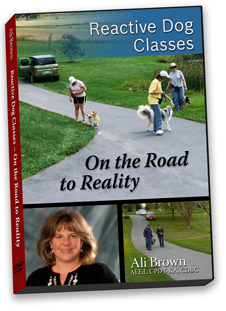
Reactive Dog Classes
On the Road to Reality
$39.95 -- Get DVD and Book!
Ali Brown's DVD showing the exercises used in her reactive dog classes. For students and teachers, learn how to use positive reinforcement, shaping, and classical contidioning to help your dog learn to tolerate the world around him. Learn more...
30 minutes: $45 -- 60 minutes: $80
Contact Ali at ali@greatcompanions.info
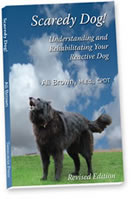
Scaredy Dog! Revised Edition
Understanding & Rehabilitating Your Reactive Dog
Buy Ali Brown's primer on fearful and reactive dogs. Including specific examples and photos to give you a better idea of what to look for and how to handle your reactive dog.
Learn More.
REACTIVE DOG Q&A
What is the difference between an aggressive dog and a reactive dog?
A dog usually displays aggression based on confidence, while a reactive dog displays actions based in fear. Aggression is a natural response, and occurs in many circumstances, including territorial protection, resource guarding, and protection of pups. While a reactive dog 'can' be aggressive, he will only likely do so if placed in a situation where he feels that there is no escape.
Why does a dog become reactive?
There are innumerable reasons why a dog might become reactive. The typical age of onset is between 18-30 months
(1 1/2 - 2 1/2 years). Genetics, lack of socialization, a single or multiple traumatic occasions, environment, and physical stressors may all be factors in your dog's reactivity. There is a whole program to follow which can help your dog. Progress can be very quick or very slow, but progress can always be made, and the quality of your dog's life (and yours) can always improve.
If my dog is reactive, or fearful or aggressive, should I take him for walks where we risk exposure to the elements that excite him, keep him locked up in the yard behind a chain link fence, or let him off leash in relative seclusion where he can't do much harm?
This is the sort of management issue that we address in our private lessons. Each dog is an individual, so some dogs can handle some situations, while others need a completely different approach. In addition, depending on how far along you are in your training program with your dog, you may be able to do certain things with him that you originally couldn't do. But mostly, it is important that with a reactive dog, he initially should be walked in quiet areas away from over stimulation, and not permitted to watch out the front window and bark at passersby, or to watch dogs or people walk by through a fence. Leaving a dog run off leash is against the law in most locations, and until you have a really great working relationship with your dog, shouldn't be done.
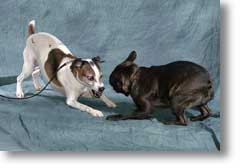
Is it aggression, reactivity, or are they
only playing? Click on the picture above
for a larger image.
There are any number of things that get my dog going…men wearing hats, people dressed in black clothes, screaming kids flailing their arms, etc. Is there hope for my dog?
Yes, there is! We can put into place a lifestyle program for you and your dog which will manage his behavior, reduce stress, and teach him default behaviors which you and he can use while out in public. Teaching these behaviors will help you and your dog to build a working relationship based on trust. Your dog will learn to trust that you will take care of him and that if he pays attention to you, no harm will come to him. Of course, that means that you really do need to ensure that bad things don't happen to him! These changes don't happen quickly, but once you start to see a change in your dog, working with him becomes so fulfilling that it often becomes addicting!
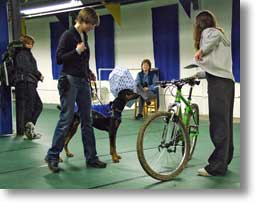
Gerda is confronted with a bicycle, a back packer, and a person with an umbrella. Click on the picture above for a larger image.
How does food influence my dog’s behavior?
Any food which taxes your dog's immune system should be avoided. Feed your dog a diet which includes high quality whole meats, multiple sources of protein, and easily identifiable fat sources (i.e., chicken fat as opposed to poultry fat). Avoid, at all costs, the use of corn, wheat and soy in your dog's food. These foods are difficult for a dog's short digestive tract to process, and are often low quality fillers, full of pesticides and molds. Also, avoid artificial flavors, colors and preservatives, as well as sugars. Find a food which includes fruits, vegetables and probiotics. Most pet food manufacturers are jumping on the bandwagon and producing foods which follow these guidelines, so the availability of such foods is rapidly increasing. These foods will provide nutrition in the most usable form, and give the dog the best possible combination of vitamins and minerals. Poor quality foods can tamper with a dog's blood sugar level, create irritability, gastric irritation, and other physical complaints which make learning difficult to impossible. If you are interested in feeding home-cooked meals or raw food to your dog, make sure you do lots of research first.
I need to know more about the circumstances in which these episodes are taking place. Private consultations are necessary to make sure we are following the right plan for your dog. The longer these behaviors occur, the more difficult it is to make positive changes. At the very least, you and your dog would benefit from building your working relationship. But there could be much more serious issues going on; in addition to scheduling an appointment with me, make an appointment with your veterinarian to rule out a medical condition, such as deafness, ear infections, arthritis, hip dysplasia, epilepsy, etc. I believe that you love your dog; let's do something to help him!
To learn more about Reactive Dogs, read Ali's book, "Scaredy Dog! Understanding & Rehabilitating Your Reactive Dog." Click here to go to the "Scaredy Dog!" page, go to the ReactiveDog.com website, or click here to email Ali about seminars, lessons or classes.
Fearful and Reactive Dogs
